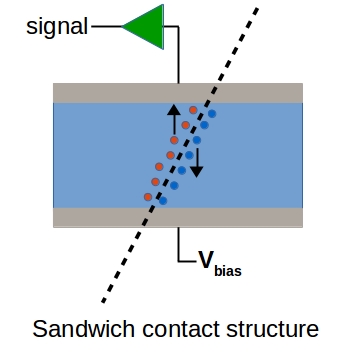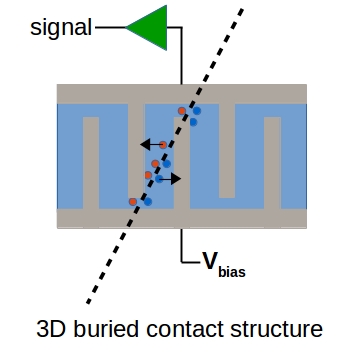Scope
Since the discovery of X-rays in 1895, there was an increasing research interest in the development of sensors able to detect radiations, properly named “detectors”.
 The principle of operation of particle or radiation detectors is the transfer of all or part of the energy of the impinging source at the mass of the detector. All modern detectors essentially provide a type of electrical response. The information from the detector is transferred into electrical signal (pulses or continuous current) which is then processed by appropriate electronic circuits. In addition to revealing the presence of a radiation, most detectors are also able to provide information about the energies of the absorbed radiation. Actually, radiation detectors find practical applications mostly in fields involving nuclear physics, material characterization, and medicine(1), so that it can be considered a multidisciplinary topic where microelectronics plays a fundamental role, allowing the realization of system able to detect and process signal generated by radiation-matter interaction. The recent evolution of microelectronics techniques allows fabrication of detectors working at higher sampling frequencies sensitive to lower and lower radiation flux.
The principle of operation of particle or radiation detectors is the transfer of all or part of the energy of the impinging source at the mass of the detector. All modern detectors essentially provide a type of electrical response. The information from the detector is transferred into electrical signal (pulses or continuous current) which is then processed by appropriate electronic circuits. In addition to revealing the presence of a radiation, most detectors are also able to provide information about the energies of the absorbed radiation. Actually, radiation detectors find practical applications mostly in fields involving nuclear physics, material characterization, and medicine(1), so that it can be considered a multidisciplinary topic where microelectronics plays a fundamental role, allowing the realization of system able to detect and process signal generated by radiation-matter interaction. The recent evolution of microelectronics techniques allows fabrication of detectors working at higher sampling frequencies sensitive to lower and lower radiation flux.
Silicon and germanium are considered the conventional semiconductor materials for radiation and particle detectors fabrication. However, wide bandgap semiconductors are presently deeply investigated for the realization of novel detectors able to work either in harsh conditions or under high-energy fluences. For example, due to the very high carbon-carbon bond strength, diamond represents one of the best radiation-tolerant material for the fabrication of devices able to detect ultra-high doses of ionizing particles, as well as high energy photons.
 The parameters involved in detection are: intensity, energy, position or mostly angles, arrival time (time-resolved experiments) and polarization. In radiation and particles detection field, the research interest does not limit only to the development of better measurement circuits but includes also microelectronic fabrication of innovative physical sensors integrating new radiation hard materials covering interest coming from fundamental physics to medicine, as well as from consumer electronics to aerospace science. In addition, to overcome any detrimental effect induced in the semiconductor by high-dose sources, much research effort is also dedicated to the realization of 3D-buried contacts structures aimed at improving the detector Charge Collection Efficiency.
The parameters involved in detection are: intensity, energy, position or mostly angles, arrival time (time-resolved experiments) and polarization. In radiation and particles detection field, the research interest does not limit only to the development of better measurement circuits but includes also microelectronic fabrication of innovative physical sensors integrating new radiation hard materials covering interest coming from fundamental physics to medicine, as well as from consumer electronics to aerospace science. In addition, to overcome any detrimental effect induced in the semiconductor by high-dose sources, much research effort is also dedicated to the realization of 3D-buried contacts structures aimed at improving the detector Charge Collection Efficiency.
In summary, scientific community, showing a great interest in solid-state detectors, aims at presently identifying novel architectures and solutions able to enhance detection capability and enlarge scientific applications, opening new challenges in detection field.
(1) Radiotherapy, bloomed in the 1920s, drove itself the development of radiation and particle detectors capable of accurately detecting the number of received particles/radiation according to the different characteristic energy of the treatment.
The proposed Technical Committee aims to
- create a network of researchers involved in the field of radiation and particle detectors;
- due to the topic multidisciplinary nature, involve: engineers, physics, doctors, biologists, chemists, but also industries and hospitals and create a community where different areas interact: physics, microelectronics, material science, measurements science, biomedicine, medical device industry;
- promote a dialogue between researchers in which innovative or state-of-the-art contributions can be shared;
- organize seminars and technical events in the field of radiation/particle detection.
Chair
Stefano Salvatori (M’00) received the Ph.D. in electronic engineering from Università degli Studi Roma Tre, Rome, Italy, in 1998. He is Associate Professor of Electronics with the Faculty of Engineering at Università degli Studi “Niccolò Cusano”, Rome, Italy. His research activity is mainly focused on diamond-based sensors for UV, X-ray, and particle detection. He is primarily involved in the development of low-noise single- and multi-channel front-end electronics for low level signal sensors. He is coauthor of about 100 scientific and technical paper.